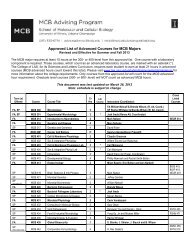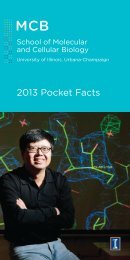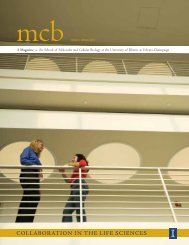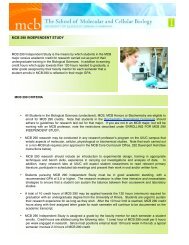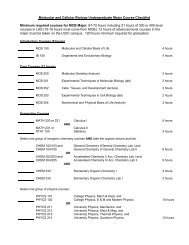breast cancer research • mcb as pre-med - The School of Molecular ...
breast cancer research • mcb as pre-med - The School of Molecular ...
breast cancer research • mcb as pre-med - The School of Molecular ...
You also want an ePaper? Increase the reach of your titles
YUMPU automatically turns print PDFs into web optimized ePapers that Google loves.
“the thing I’ve come to value about the MCB curriculum is the emph<strong>as</strong>is on problem<br />
solving skills. I took away a great deal <strong>of</strong> knowledge about biology, but the ability<br />
to think through complex ide<strong>as</strong> h<strong>as</strong> helped me succeed more...”— Dan thorngren,<br />
MCB graduate, former Nardulli Lab Research Specialist, <strong>med</strong>ical school student<br />
ann nardullI<br />
In an effort to better understand just how the DNA-bound ER regulates gene ex<strong>pre</strong>ssion, Pr<strong>of</strong>essor <strong>of</strong> <strong>Molecular</strong> and Integrative<br />
Physiology Ann Nardulli isolated and identified proteins <strong>as</strong>sociated with that complex.<br />
Among the 200 proteins Nardulli identified, she found a group <strong>of</strong> oxidative stress response proteins, which are responsible for reducing<br />
the level <strong>of</strong> reactive oxygen species in cells. At normal levels, reactive oxygen species are useful for signaling and maintaining a cell’s<br />
normal environment, but too much can damage proteins, lipids, and DNA.<br />
Nardulli also found another group <strong>of</strong> proteins that repair DNA. If DNA is damaged and, for example, the DNA repair proteins are<br />
under-ex<strong>pre</strong>ssed, DNA might not be efficiently repaired. Nardulli began to think that the over- or under-ex<strong>pre</strong>ssion <strong>of</strong> the oxidative<br />
stress response or DNA repair proteins might be involved in the development and/or progression <strong>of</strong> <strong>bre<strong>as</strong>t</strong> <strong>cancer</strong>.<br />
“We wondered, if we looked at normal mammary tissue, benign hyperpl<strong>as</strong>ia, ductal carcinoma in situ, and inv<strong>as</strong>ive <strong>bre<strong>as</strong>t</strong> <strong>cancer</strong>,<br />
would we see a difference in the ex<strong>pre</strong>ssion <strong>of</strong> these proteins?” says Nardulli.<br />
Nardulli’s group looked at the ex<strong>pre</strong>ssion <strong>of</strong> 12 different proteins in 96 <strong>bre<strong>as</strong>t</strong> biopsies to see if there w<strong>as</strong> a pattern <strong>of</strong> over- or underex<strong>pre</strong>ssion<br />
<strong>of</strong> any <strong>of</strong> the proteins. Nardulli h<strong>as</strong> some very intriguing findings so far. For example, a DNA repair protein that is ex<strong>pre</strong>ssed<br />
in normal <strong>bre<strong>as</strong>t</strong> tissue is not ex<strong>pre</strong>ssed in inv<strong>as</strong>ive <strong>bre<strong>as</strong>t</strong> <strong>cancer</strong> tissue.<br />
“That seems to be a dangerous situation if a protein required for DNA repair is no longer <strong>pre</strong>sent to repair damaged DNA,” she says.<br />
This also ties in with other observations Nardulli h<strong>as</strong> made about how some <strong>of</strong> these proteins, which are normally found in the<br />
nucleus <strong>of</strong> normal cells, end up outside the nucleus in tumor cells.<br />
“If you change the location <strong>of</strong> proteins that normally reside in the nucleus so they no can no longer access DNA or reduce their ex<strong>pre</strong>ssion,<br />
you can accumulate DNA damage. That is one way <strong>cancer</strong> might occur or progress.” <strong>•</strong><br />
Photographs <strong>of</strong> Sligar, Shapiro, Nardulli, and Luthra by Nick Burchell<br />
SCHOOL OF MOLECULAR AND CELLULAR BIOLOGY . 9






